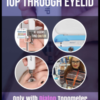At #VisionExpo Don’t Miss this “Scleral Lens & IOP” discussion. Team of researchers from Pacific University College of Optometry in the study “Does IOP Increase During Scleral Lens Wear?” say Yes
— Lean More at Booth #4037 Diaton Transpalpebral, Scleral Tonometry Event Details: https://tonometer.wpengine.com/event/tonometer-diaton-featured-at-vision-expo-2018-in-las-vegas/

Does IOP Increase During Scleral Lens Wear? Scleral Tonometer Diaton Helps to Answer:
Steve Turpin OD, Kennedy Antoniuk, Patrick Caroline, Randy Kojima, Beth Kinoshita OD, Matthew Lampa OD, Mark André
Pacific University College of Optometry, Forest Grove, Oregon
Introduction: Concerns have been raised about potential unintended long term side effects of scleral lens wear. One of these side effects is a potential change in intraocular pressure (IOP). One study investigated IOP changes with 15.0 mm diameter scleral lens wear using a pneumatic tonometer on the temporal scleral. The overall results suggested that the IOP did not increase with two hours of lens wear within the study group.1 However, there was a marked increase in pressure of individual subjects.1 These findings indicate that in some cases, scleral lens wear can affect IOP. Our study used a novel IOP measurement device called the Diaton tonometer (BiCOM Inc http://www.TonometerDiaton.com ).

Material and Methods: Fourteen normal eye subjects were fitted with two different scleral lens designs ranging in diameter from 14.6 to 15.2 mm. Subjects’ baseline IOP was measured with both the Diaton and Goldmann Applination Tonometry at 8:00 AM and 4:00 PM. The following day, the first pair of scleral lenses were applied at 8:00 AM and the IOP was measured using the Diaton immediately after application and after 8 hours of wear. The lenses were then removed and the IOP was measured immediately with the Diaton. The procedure was then repeated the following week with the second pair of lenses. Six IOP measurements were taken and averaged each time the Diaton was used. Two Goldmann measurements were averaged
Results: The Diaton measures IOP through the upper eyelid to the scleral surface. This allows clinicians to monitor IOP while scleral lenses are being worn. The correlation between IOP measurements taken with the Diaton and Goldmann were significant. 73.2% of observed Goldmann values fell within ±2 mmHg of the predicted Goldmann values predicted by our linear regression model. Immediately following lens application, IOP increased (above baseline) in all subjects in both lens designs A and B. The increase in IOP was not significantly different between the two lens designs. The average increase in IOP for both lens designs was 5.5 mmHg.
Discussion: We observed that immediately following scleral lens application, the IOP increased in all of the test subjects. The initial IOP increase averaged 5.5 mmHg. The pressure appears to remain elevated throughout the wearing time (average 7.0 mmHg increase from baseline prior to removal), then immediately returns to baseline following scleral lens removal. This suggests that the suction force beneath the lens is a primary contributor to the IOP changes. These suction forces may also be responsible for such phenomenon as conjunctival prolapse. However, narrowing of the iridocorneal angle or compression of the trabecular meshwork and/or Schlemm’s canal due to the suction of the lens can not be ruled out as possible contributing factors to the IOP changes. Please see the poster for details and graphs.
#optometry #sclerallens #visionexpo2018 #tonometry #glaucoma #optometrist #optometrists #sclerals #IOP #intraocularpressure #cornea #diaton_Tonometer #tonometer_diaton #eye_tonometer #eye_tonometry #tonometer_pen #pen_tonometer
Scleral Lenses: are used during the conditions like #cornealectasia, #ocular #ocularsurfacedisorders like severe #dryeyes #dryeye, #StevenJohnson’s syndrome, also during corneal conditions which can #posttransplants, #eyetrauma or #cornealscars etc.








